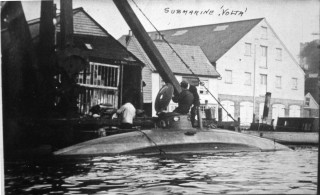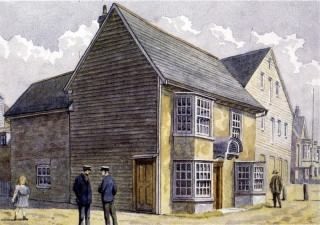About The Ship at Launch (formerly The Woolpack) 18th Century -1910
Once on The Quay, at the corner with Bath Street
Sue Glasspool
The Pub Trail Index – click here
Walk down Bath St towards the Quay and suddenly there is a kink in the road, to the left. You are now standing on the site of the Ship at Launch and the Georgian baths which it was hoped would make Wivenhoe a famous spa town.
Eighteenth century
The first known reference to The Woolpack is in the licensing records (known as Alehouse Recognizances*) of 1728. There is also reference in the same year in the rent book of Nicholas Corsellis IV, the Lord of the Manor. It refers to Mary Flack renting “1/2 Woolpack” from him. This ties in with a Horace Flack who in 1750 opened a public spa bath (hence Bath Street) situated in buildings at the back of The Woolpack. On Horace’s death his assistant Thomas Tumner took over the baths which flourished until the end of the century as he advertised the therapeutic effects of sea- bathing. The public house and baths were all part of the same premises as can be seen from a manorial document (ERO D/DEl T379).
“ And also all that piece of ground whereon a Bath and other buildings are now standing …. being heretofore part and parcel of the premises formerly called The Woolpack and since or now called by the sign of The Ship at Launch “.
The pub’s name was changed in 1781 probably to better reflect its position next to the successful upstream shipyard and its shipyard worker clientele. In 1799 John Bawtree acquired the freehold of much land and property from Nicholas Corsellis including The Ship at Launch.
Nineteenth century 1800 -1850
In 1828 mortgage documents show that the licensee was Samuel Wade. He was a local coal merchant and was in the same year also the licensee of The Flag, and of The Greyhound in 1836. It was probably through his business acumen that circa 1830 the public house was enlarged and improved for the comfort and accommodation of “respectable company” to including a spacious Club Room and additional stabling. This was a worthwhile investment as, at this time, there were no public halls in Wivenhoe, so public houses with function rooms became places where gentlemen would gather for official meetings, either for business or local organisations, and community events. The local newspaper had many advertisements on its front page for auctions of houses, ships, fishing gear, salvaged goods etc- all taking place at Wivenhoe public houses. There is even a report from 1850 of an inquest taking place at The Ship at Launch following a drowning incident on the river (ES 24 May 1850).
In 1833 the pub was bought by the Colchester brewers Cobbold and Co. From 1836 to 1849 George Chamberlain was the licensee. He is recorded as leading a Dissenters revolt in 1840 refusing to pay a rate for the upkeep of St Mary’s Church (ES 23 October 1840).
It was about this time that public houses began to organise benefit clubs and/or medical clubs and The Ship at Launch had such a club. We are fortunate that Wivenhoe’s Dr Dean presented the original Medical Club Ledger to the Essex Record Office in 1988 so that we can see how these were organised and the amounts of money paid over to the doctors (ERO C227 Box 1).
Nineteenth century 1850-1900 and beyond
The investment in the building was put in jeopardy twice in the next fifty years. In 1872 there was a huge fire in the shipyard next door; many buildings in the yard were destroyed and it must have been a very worrying time for the landlord. Then the 1884 earthquake severely damaged the rear of the building. Although this was a more prosperous period in the town’s history due to the fashionable yachting fraternity descending on Wivenhoe , sales decreased in the 1880s and 90s. The pub closed in 1910 and was demolished circa 1916 to enable the diversion of the Quay end of Bath Street to the east for shipyard expansion.
*Alehouse Recognizances – early public house licences. The licensee appeared before the licensing justice each year. He/she would pay a sum of money (bond) as a guarantee of their good behaviour; breaching the conditions would mean forfeiture of their licence and the money. These documents appear in the Quarter Session records held at Record Offices.
Links to other pages on this website:
- Ship at Launch – Deed (1828) and other entries
- Wivenhoe and the earthquake
- Bawtree/Hawkins Family Connection
- Landlords & Breweries in Wivenhoe
- Benefit/medical clubs
References:
- ES: Essex Standard
- ERO: Essex Record Office
General Sources:
- Butler N, “The Story of Wivenhoe”, Quentin Press Wivenhoe, 1989.
- Collins J, and Dodds J, “River Colne Shipbuilders”, Jardine Press 2009.
- Haining P, “The Great English Earthquake”, Robert Hale Ltd 1976.
- Kay P, “Wivenhoe Pubs”, published by Peter Kay 2003.
The Pub Trail Index – click here

![Ship At Launch [WMC] The Ship at Launch Wivenhoe Quay c.1900 | Photo: Wivenhoe Memories Collection](https://www.wivenhoehistory.org.uk/wp-content/uploads/2020/08/Ship-At-Launch-WMC-320x221.jpg)








No Comments
Add a comment about this page